Diving
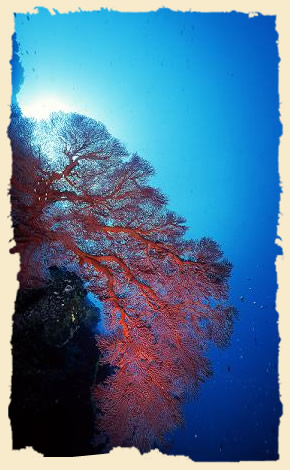
Our dive shop, “ Peleliu Divers,” has been operating since 1996. It is the first dive shop on the island. It is Palauan owned and operated by Godwin Sadao, one of Palau's most knowledgeable divers and boat captains, and his staff of experienced dive guides.
We have 2 fully equipped dive boats for daily dive trips, with a maximum of 8-9 divers on a boat.
The great advantage for divers and snorkelers staying at Dolphin Bay Resort is that we are so close to all the famous diving and snorkeling areas. Almost all of Palau's best known dive sites are located within a twenty-minute boat ride from our resort. For example, it takes less than 20 minutes to reach the Blue Corner and Blue Holes, about 10 minutes to travel to the German Channel and Big Drop-off, and 5 minutes to travel by boat to the Peleliu Corner, Peleliu Express, and Peleliu Drop-off.
You'll enjoy getting to the dive sites ahead of the boats from Koror, and staying longer, as well.
Information for Divers
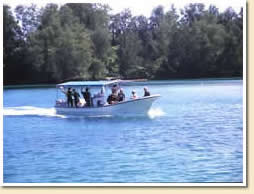
Dive Boat:
29 foot, double engine, covered (protection from sun and rain)
Diving style:
we practice eco-friendly diving ("look but don't touch"), with an emphasis on safety and buoyancy control. Our dive guides give a briefing before each and every dive, and we encourage divers to monitor their air consumption closely. To enter the water, we usually use simple "back entry" rolls and we exit the water with a ladder on the side of the boat.
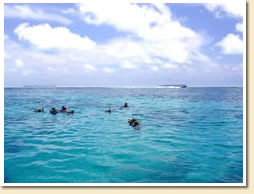
Drift Diving:
Most dives in Palau are drift dives, usually in gentle to moderate currents, but on occasion, currents can become strong, which is why we ask all divers to carry their own signal float.
Water Temperature:
It is warm year-round, usually about 28-29 degrees Celsius or about 80-84 degrees Fahrenheit.
Current Hook:
A current hook is used to attach divers to rocks at the edge of walls so they can relax in the current and watch marine life and avoiding the holding or stepping the corals and destroy.
Rental Gear:
All essential equipment is available for rent, including BCD, Regulators , Fins, Wet suits, Masks, Boots, Current hooks.
Dive Gear:
Washing and Storage: there is a large rinse tank, drying area, and storage room for your dive gear. Baskets are available. The storage area is locked when not in use by divers.
Diving Permits:
Koror State/Rock Island Permit is valid for 10 days ($25 for diving only; $35 for diving and Jellyfish Lake); For diving in Peleliu waters, you will need a Peleliu State Permit, valid for 14 days ($20).
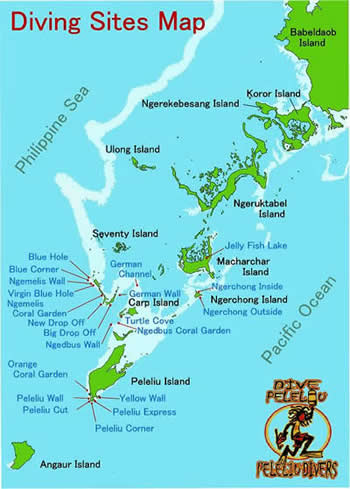
PALAU DIVE SITES
The following dive sites are frequented by Peleliu Divers. We have detailed maps available at the resort, fish identification books, and detailed information about Palau's diving sites.
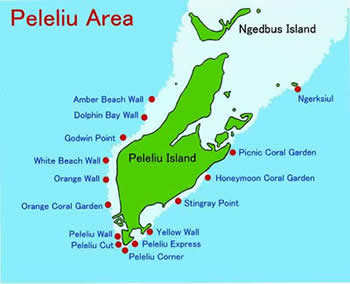
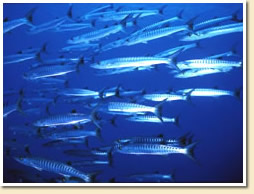
1) Blue Corner
The best known and most famous dive site in all of Palau, the Blue Corner is a true underwater wilderness which is home to large schools of barracuda and jacks, large numbers of white-tip, black-tip and grey reef sharks, as well as sea turtles, napoleon wrasse, rays, schools of bumphead parrotfish, and literally hundreds of other species visible at any one time.
2) Blue Hole
This dive begins on the top of a shallow reef, descending through one of four large holes into a gigantic submarine cavern. The cavern provides several large exits to the open ocean, starting between 40 and 85 feet below the surface. Inside the twisting tunnels and chimneys that connect this coral fortress to the sea and sky are beautiful soft corals and sea fans. A good place for flashlights to illuminate the colorful walls and ceiling. The holes are very close to the Blue Corner and, when conditions are good, divers can exit the Blue Holes and finish their dive drifting to the corner.
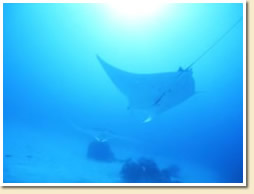
3) German Channel
A man-made channel through the southwest side of the reef leads to a sandy area, that is home to a “cleaning station” where divers can crouch motionless on the sand and watch manta rays and large reef sharks being groomed by cleaner wrasses at a depth of approximately 50 feet. The area is also inhabited by garden eels, barracudas, snappers, leaf fish and octopus. On both sides are coral gardens that features crocodile fish, nudibranchs, anemones and clownfish.
4) Big Drop Off
One of Palau's best places for combining snorkeling and diving. Snorkelers explore the top of the reef in shallow water, looking over the edge of the wall. Divers usually drift slowly along the wall, at depths from 40-80 feet surveying the abundant hard and soft corals, sea fans, and large schools of tropical reef fish.
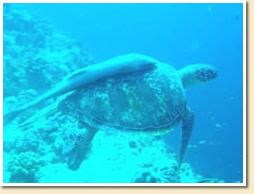
5) Turtle Cove
A popular site, also good for combining diving and snorkeling. This is a wall dive, usually explored at depths of roughly 60feet/18m, where the larger life, such as sharks, rays, large turtles are found. In the shallower areas are large schools of reef fish, numerous anemones, and sometimes smaller turtles. The sandy flat area between the nearby rock island and the cliff is a good place for a lunch break and snorkeling.
6) Ngedebus Coral Garden
This is a good site for beginner divers, only a short boat ride south of Turtle Cove. It is also a great site for all divers who like hard corals and exotic marine life, including crocodile fish, lion fish, and rays. It is also an excellent place for underwater photography and video, due to the rich coral mounds, gentle underwater conditions, and moderate depths.
7) Ngedebus Wall
Ngedebus Wall is at a corner of Ngedebus coral garden. You can dive the wall to the corner, where you can watch all the underwater action along the reef.
8) New Drop-Off
This is an advanced dive, in 20-120 feet of water, located around the corner from Big Drop-off. There are often lots of currents, bringing schools of large fish, including sharks, along the wall. The wall is also alive with small tropical fish and other creatures. This is a "bottomless" wall, so keep an eye on your depth gauge.
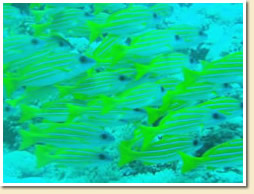
9) Virgin Blue Hole
Starting on the top of the shallow reef, divers descend down the hole, past walls with sea fans and hiding fish, to the depth of 90 feet. There a tunnel exits to the open sea and divers continue along the wall, seeing beautiful soft corals, sea fans, cruising eagle rays, turtles, and on occasion, the rare leopard shark.
10) Ngemelis Wall
Gorgeous soft corals on the wall, seafans and lots of colorful reef fish, especially school of pyramid butterfly fish. Often sea turtles, grey reef sharks, and white tip sharks are cruising the wall.
11) Ngerchong Inside
It offers a gentle slope with diverse corals and wide variety of reef fish, including at times cuttlefish, ghost pipefish, and zebra sharks.
12) Ngerchong Outside
This is a wall dive and home to many large Gorgonian Sea fans, reef fish, and reef sharks.
13) Peleliu Wall
One of the beautiful wall dives. Lots of colorful soft corals, including black corals, and huge sea fans cover the wall. Large numbers of tropical reef fish live here, including pyramid butterfly fish, square anthias, moorish idols, sergeon fish, bumphead parrot fish, trigger fish, and scorpion leaf fish. Larger fish include grey reef sharks, white tip sharks, barracuda, and jacks. On rare occasions, sailfish, marlin, and bull sharks visit this area.
14) Peleliu Cut
Starting from the Peleliu wall, divers follow the current through the Peleliu cut. The top of the Peleliu Cut is about 45 feet depth. We use the reef hook, hooked on the top of the reef, to see grey sharks and white tip shark are cruising around us.
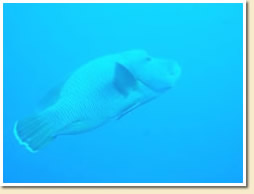
15) Peleliu Corner
This dive starts at the Peleliu Express and goes to the corner, or starts from Peleliu Cut and goes to the corner. The depth is about 75 feet. Divers can see schools of giant travelly, big grouper fish, white tip sharks, schools of baraccuda, napoleon wrasse. This is an extreme advanced dive -- be aware of extreme down currents.
16) Peleliu Express
There can be extremely strong current, or mild current, or no current at all. The wall is home to yellow soft corals, small reef fishes, and possibly schools of the sharks like grey reef shark. The strong current attract sharks, barracuda, tuna, and rays. Huge giant travelly fish, groupers, drift off the wall to the blue ocean. During our safety stop, divers can possibly see blue marlin, a school of rainbow runners, sailfish, or a whale shark.
17) Yellow wall
Peleliu East dive site. Divers drift along the wall to see the tiny soft yellow corals covering the wall. There are also giant sea fans on the wall, grey reef sharks, sometimes eagle rays, schools of barracuda, and rarely, blue marlin.
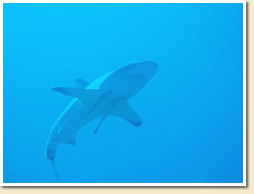
18) Stingray Point
East of Peleliu, this is a vertical wall and drop off. At the depth of 15 feet, on top of the reef, there is sandy area where we can see sleeping sting rays, dragon wrasses, and reef fish. Along the wall there are colorful sea fans. Rarely can be seen Blue Marlin.
19) Orange Coral Garden
This has a sloping wall with lots of beautiful soft corals, table corals, hard corals, Giant moray eels, schools of barracuda, jacks, buffaro fish, and white tip sharks. You can find WWII relics under the water, such as a ship anchor, chain, bombs and bullet shells.
20) Orange wall
This is a vertical wall where divers can see the big sea fans, and anemones with many anemone fish. Schools of black snapper, sea turtles, grey reef sharks and white tip sharks are cruising along the wall.
21) Godwin Point
Starting from the wall dive, we see lots of sea fans on the wall and schools of butterfly fish. Crusing around the wall, heading up to the slope area, we put the reef hook on the top of the reef and watch fish swim by; or continue the drift dive along the top of the wall. There are many colorful soft corals, giant clams, schools of black snapper and barracuda.
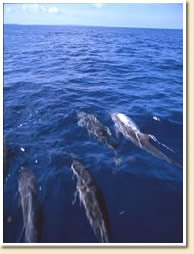
22) Dolphin Bay
Start from the white beach, all the way to the Ngedbus reef, on the west side of Peleliu. You can possibility to see the school of spinner dolphins that lives here. They enjoy riding the bow wake of the boat, so when driving the boat, they are jumping and spinning, and cruising alongside the boat together.
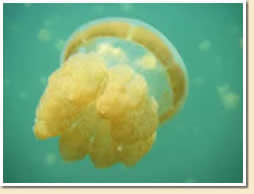
23) Jellyfish Lake
Jellyfish Lake is a famous marine lake located deep in a Rock Island. It is home to millions of stingless jellyfish who pulse slowly across the water each day following the sun. The jellyfish have developed a symbiotic relationship with algae that they carry, tend, and live on. Thus they follow the sunlight to keep their algae healthy. Our boat will take you to the dock at Jellyfish Lake. From there you will hike on a path up a steep hill, then down through the jungle to the dock at the lake. To find the jellyfish, snorkel out into the lake, into the sun. The jellyfish are extremely delicate; take great care when swimming through them.
